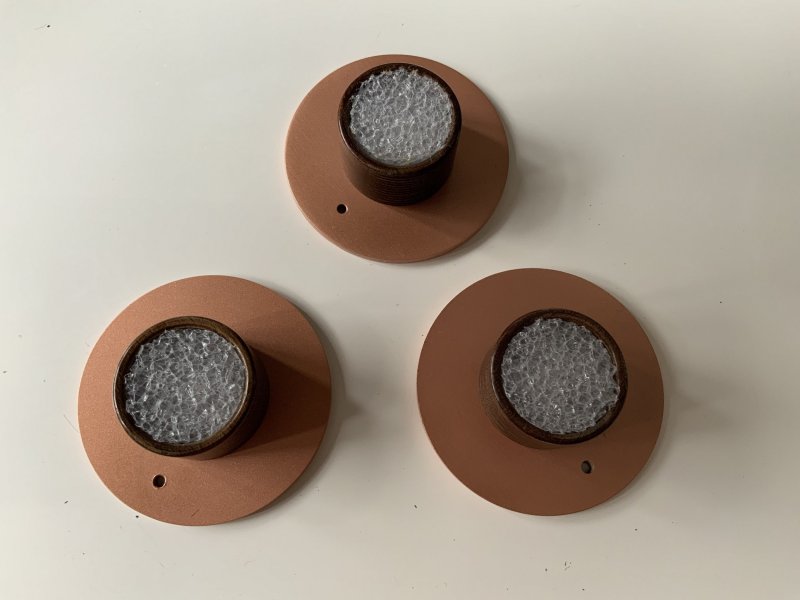...well, these things do get complicated quickly, having so many variables.
I did have a flashing thought to write back: audiophiles are confused because it's a complicated topic and there are reasonable, intelligent designers making products that seem to work in completely different ways!
Drain the vibrations away with rigid footers...or...isolate the devices with more compliant products?
Both approaches make sense, but I think one would have to run the tests with "your" system and draw the conclusions for that set of variables, which comprises the only set that really matters (to a user).
My system sounds terrific, but I often tinker around a bit and consider what I might do to improve. I wouldn't say I'm compulsive about it, but I do wander into the "what if" zone at times.
I was considering: double-Daiza strategy, and/or Critical Mass footers? Existing Daiza on Symposium amp stand for Extreme?
I ordered the heavier EVPs yesterday and will put them under the Extreme and run the test. What else can one do? The tests with smaller EVPs under the MSB are excellent.
I take that to mean, in my room, whatever vibrations are present internal to the dac or external in the room are all working within the goals/limitations of the MSB engineering team, and their understanding of the physical properties of the planet.
I think where the Taiko team have a real advantage, and what was the tipping-point for me to become a customer, is that they are trying to integrate a system for the Extreme...to integrate and control the variables to the extent possible (hardware, software, USB, network, etc.). They make the Daiza and the machine it was built for. It works well for other devices too, but it *must* work for the Extreme.
We use these forums to communicate our varied use cases and how we think we hear things at home. Some of the things don't seem to make sense...but seem to sound good. That's a sticker.
There are a lot of variables, and every reader owns the obligation to consider any comments in the context they were provided and whether the person seems to make sense if one were to adopt their strategy, or try a given product.
BTW: To me, you are within the Laws of Physics and Forums (101!) to highlight the various comments you called out. In fairness, I did only post an excerpt from the email to add to exiting posts, but it was not atypical of the whole.
I did have a flashing thought to write back: audiophiles are confused because it's a complicated topic and there are reasonable, intelligent designers making products that seem to work in completely different ways!
Drain the vibrations away with rigid footers...or...isolate the devices with more compliant products?
Both approaches make sense, but I think one would have to run the tests with "your" system and draw the conclusions for that set of variables, which comprises the only set that really matters (to a user).
My system sounds terrific, but I often tinker around a bit and consider what I might do to improve. I wouldn't say I'm compulsive about it, but I do wander into the "what if" zone at times.
I was considering: double-Daiza strategy, and/or Critical Mass footers? Existing Daiza on Symposium amp stand for Extreme?
I ordered the heavier EVPs yesterday and will put them under the Extreme and run the test. What else can one do? The tests with smaller EVPs under the MSB are excellent.
I take that to mean, in my room, whatever vibrations are present internal to the dac or external in the room are all working within the goals/limitations of the MSB engineering team, and their understanding of the physical properties of the planet.
I think where the Taiko team have a real advantage, and what was the tipping-point for me to become a customer, is that they are trying to integrate a system for the Extreme...to integrate and control the variables to the extent possible (hardware, software, USB, network, etc.). They make the Daiza and the machine it was built for. It works well for other devices too, but it *must* work for the Extreme.
We use these forums to communicate our varied use cases and how we think we hear things at home. Some of the things don't seem to make sense...but seem to sound good. That's a sticker.
There are a lot of variables, and every reader owns the obligation to consider any comments in the context they were provided and whether the person seems to make sense if one were to adopt their strategy, or try a given product.
BTW: To me, you are within the Laws of Physics and Forums (101!) to highlight the various comments you called out. In fairness, I did only post an excerpt from the email to add to exiting posts, but it was not atypical of the whole.








